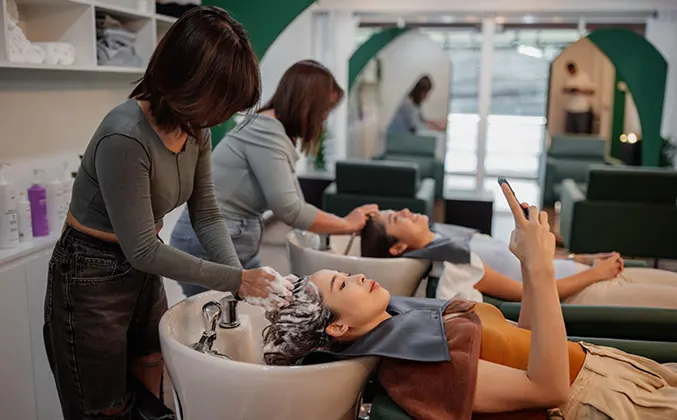A salon receptionist’s duties are to greet clients, manage bookings, handle payments, coordinate staff, support retail sales, maintain compliance, and reduce no-shows. These responsibilities make the difference between a chaotic salon and a successful one.
And if you are wondering, ‘How does a salon receptionist make a salon successful?’ A well-trained receptionist doesn’t just answer phones; they are the first and last impression of your business. They protect revenue, improve client experiences, and keep the entire operation flowing. Now, let’s look at salon receptionist duties in detail.

1. Greeting & client care
The way clients are welcomed sets the tone for the entire salon experience. The very first “hello” can decide whether a client feels valued or overlooked. Receptionists are the face of the salon, professionally and warmly building a loyal client base. Besides this, their duties include:
- Greeting every client warmly within five seconds of arrival.
- Using names wherever possible: “Hi Sarah, welcome back, Jake is just finishing up”.
- Offering comfort: water, tea, or adjusting the waiting area.
- Managing wait times with honesty: “It looks like a 10-minute wait. Let me make sure you’re comfortable.”
- Passing along important notes to the stylist (allergies, preferred products, past issues).
People remember how they felt. A polished front-desk welcome increases rebook likelihood and word-of-mouth referrals.
Here’s an implementation tip: Add client notes in your booking software. Reading them before greeting can personalize every interaction.
2. Scheduling & booking mastery
Scheduling is the heartbeat of salon efficiency. If scheduling is sloppy, nothing else works. Bookings become a mess of double appointments, empty gaps, and lost revenue. A successful receptionist:
- Uses software for salon business to book and adjust appointments without overlap.
- Fills canceled slots by quickly reaching out to the waitlist.
- Coordinates multi-service bookings, making sure clients move seamlessly from hair to nails to spa.
- Encourages rebooking before clients leave, securing future revenue.
Poor scheduling does not just inconvenience staff; it frustrates clients and reduces profitability. And a receptionist is the gatekeeper of time, ensuring every chair and treatment room generates value.
Revenue protection tip: Create a policy that rebookings happen at checkout. Receptionists should gently ask: “Would you like me to book your next visit now? That way, you secure your preferred time.” This reduces no-shows, chairs stay filled, and clients stick around longer.
3. Payments & admin
Handling money is one of the most sensitive parts of the receptionist’s role. Accuracy in billing builds trust, while mistakes can damage client relationships and the salon’s credibility. At checkout, clients want fast and mistake-free service. So, the receptionist role here includes:
- Processing payments (cash, card, mobile wallet).
- Applying loyalty points, gift cards or discounts.
- Handling refunds, exchanges, and receipts.
- Reconciling the till at day’s end.
A skilled receptionist doesn’t just collect payments; they also explain service charges, upsell product bundles at checkout, and manage client accounts in your salon software. This ensures a smooth, transparent process that leaves no room for confusion.
4. Retail & upselling
Many salons overlook the receptionist’s potential as a sales driver. The receptionist is often the last person a client interacts with. The receptionist is in the perfect position to recommend aftercare products and services. For example, they can:
- Promote retail products at checkout.
- Suggest add-ons like scalp massage treatments or quick trims.
- Encourage product bundles during promotions.
Also, remember, upselling is subtle, not pushy. A receptionist might say, “Since you loved today’s facial, would you like me to book the same for next month at the same time?” This secures repeat revenue while making the client feel cared for.
Receptionists who master upselling add thousands in revenue over the year, often more than a stylist could through services alone. You can even have a KPI to track it. Here’s the simplest way to do it.
Retail attachment rate = (retail transactions ÷ total transactions) × 100.
Don’t forget to set monthly goals and celebrate improvements.
5. Communication hub
Receptionists manage every client touchpoint, especially communication. They are the bridge between clients and the salon team. Their responsibilities include:
- Answering calls promptly and politely.
- Responding to emails, texts, or web inquiries.
- Confirming and rescheduling appointments via phone/SMS.
- Managing online chat (if enabled).
- Forwarding urgent issues to managers or stylists.
They also act as a buffer, handling complaints or rescheduling issues with tact before they escalate. For instance, if a stylist runs late, the receptionist smooths things over by informing the client promptly and offering a small gesture, like a complimentary beverage.
Effective communication doesn’t just solve problems; it keeps clients coming back.
Pro tip: The receptionist should track common client questions, then the salon can build on the FAQ or script library to save time.
6. Marketing & client retention support
While running campaigns does not come in salon receptionist duties, they support marketing directly.
They manage referral program tracking, distribute loyalty cards, and remind clients about ongoing promotions at checkout. Receptionists also gather client data (emails, birthdays, preferences) that feeds into automated marketing campaigns.
For example, a receptionist who captures birthdays enables your salon to send automated “birthday discount” emails, a proven way to boost bookings.
Their small, daily contributions to marketing make a big difference in long-term growth.
7. Team & operational support
Receptionists are not just client-facing; they also coordinate internally.
They coordinate schedules so stylists are not overbooked or left idle, manage supplies by notifying staff when stock is low, and keep the salon floor running smoothly.
When emergencies arise, like a stylist calling in sick, the receptionist reorganizes the schedule, contacts affected clients, and prevents revenue loss.
In short, they’re the glue that holds daily operations together.
8. Compliance, privacy & safety
Receptionists are often the unsung heroes of compliance. They manage consent forms, allergy checklists, and patch test records, and ensure new clients fill in required documentation before services begin.
They also play a role in health and safety: monitoring sanitation protocols, ensuring PPE is stocked, and keeping emergency contacts ready.
By staying vigilant, they protect the salon from legal risks and show clients that their health is a top priority.
9. KPIs to measure success
The role is measurable, and the receptionist directly influences key performance indicators (KPIs), such as:
- Client retention rate (percentage of clients who rebook).
- Average retail sales per client.
- Waitlist utilization rate.
- Accuracy of daily cash reports.
- Client satisfaction feedback.
Tracking KPIs transforms receptionist duties from routine tasks into measurable business drivers.
10. Training & career path
Receptionists stay longer and perform better when they are given the room to grow. Training in customer service, conflict resolution, and salon software empowers them to perform at their best. Cross-training in retail or marketing also boosts their value.
Career progression keeps receptionists motivated. Many grow into salon managers or coordinators, bringing years of operational knowledge with them. Investing in their growth reduces turnover and strengthens the salon’s leadership pipeline.
11. The daily checklist
Here is a practical overview of what a receptionist does every day:
- Open the salon: prepare the front desk, check bookings, and set up POS.
- Throughout the day: Greet clients, answer calls, update schedules, manage retail sales, support staff.
- End of day: Confirm tomorrow’s bookings, balance payments, close POS, and secure the salon.
A structured daily checklist ensures nothing falls through the cracks, from client greetings to financial close-outs.
Last thoughts
A receptionist is not just a front desk presence. They are the first impression, the last interaction, and the constant connector in between. Done right, they increase client satisfaction, drive revenue, and make the salon run smooth.
If you are a salon owner, don’t see the receptionist as a cost. See them as your growth partner. Equip them with training, empower them with the salon management software and watch the difference.
For smooth salon management, Wellyx makes the job easier. Automating reminders, managing records, and integrating payments, but it is the person at the desk who brings it all to life.





